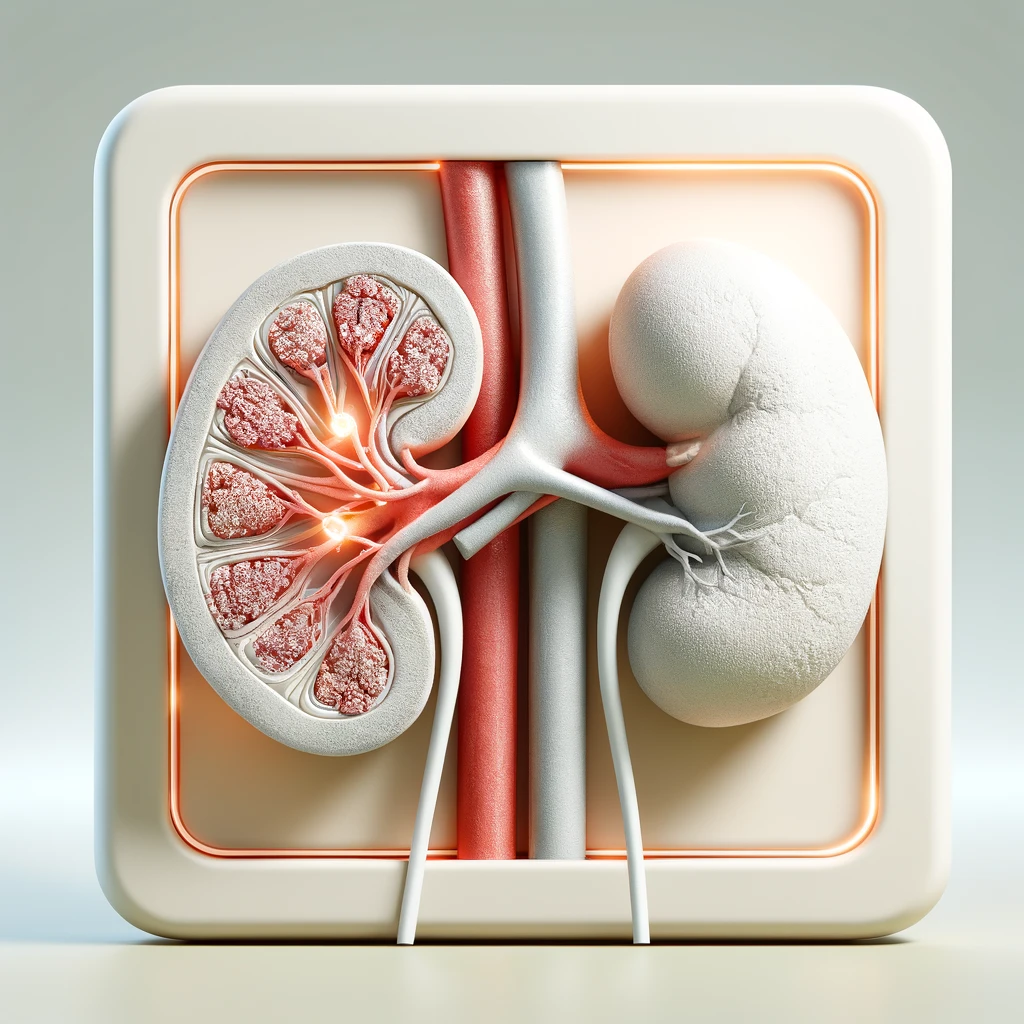
Vascular calcification is a prevalent and significant complication in patients with Chronic Kidney Disease (CKD). It contributes to the high cardiovascular morbidity and mortality seen in this population. The process involves the deposition of calcium-phosphate complexes in the vascular walls, leading to increased arterial stiffness and compromised cardiovascular function.
Causes of Vascular Calcification in CKD
The pathogenesis of vascular calcification in CKD is multifactorial, involving a complex interplay of mineral metabolism disorders, uremic toxins, and alterations in vascular smooth muscle cells (VSMCs).
- Mineral Metabolism Disorders: CKD disrupts the balance of calcium, phosphate, parathyroid hormone (PTH), and vitamin D, leading to secondary hyperparathyroidism and dysregulated mineral metabolism. Elevated serum phosphate levels and PTH contribute to the precipitation of calcium-phosphate complexes in the vascular walls. Additionally, reduced levels of calcification inhibitors such as fetuin-A and matrix Gla-protein further promote calcification.
- Uremic Toxins: Accumulation of uremic toxins in CKD patients contributes to endothelial dysfunction and inflammation, creating a pro-calcific environment. These toxins can induce oxidative stress and upregulate pro-inflammatory cytokines, which stimulate osteogenic differentiation of VSMCs.
- Vascular Smooth Muscle Cell Differentiation: VSMCs in CKD patients undergo phenotypic changes, shifting from a contractile phenotype to an osteogenic phenotype. This transformation is driven by elevated phosphate levels, inflammatory cytokines, and oxidative stress, resulting in the expression of bone-related proteins such as osteocalcin, bone morphogenetic proteins, and alkaline phosphatase, which contribute to vascular calcification.
- Hyperphosphatemia: Elevated serum phosphate levels are a critical driver of vascular calcification in CKD. Phosphate directly stimulates VSMCs to undergo osteogenic differentiation and promotes the deposition of calcium-phosphate crystals in the arterial walls.
- Disturbances in Calcium-Phosphate Product: The calcium-phosphate product, which is the multiplication of serum calcium and phosphate concentrations, is often elevated in CKD patients. This imbalance facilitates the deposition of calcium-phosphate in the vascular matrix, leading to calcification.
Clinical Implications
Vascular calcification has profound clinical implications for CKD patients, significantly increasing their cardiovascular risk and mortality. The primary clinical consequences include:
- Increased Arterial Stiffness: Vascular calcification leads to stiffening of the arterial walls, reducing their compliance and elasticity. This results in increased systolic blood pressure and pulse pressure, which can exacerbate left ventricular hypertrophy and heart failure.
- Reduced Coronary Perfusion: Calcified coronary arteries have reduced ability to dilate in response to increased myocardial demand, leading to compromised coronary perfusion and increased risk of myocardial ischemia and infarction.
- Enhanced Risk of Cardiovascular Events: Vascular calcification is a strong predictor of cardiovascular events such as myocardial infarction, stroke, and peripheral artery disease. It significantly contributes to the high cardiovascular mortality observed in CKD patients.
Therapeutic Approaches
Managing vascular calcification in CKD patients requires a comprehensive approach targeting the underlying causes and mitigating the progression of calcification. Current and emerging therapeutic strategies include:
- Phosphate Binders: Controlling serum phosphate levels is crucial in preventing vascular calcification. Phosphate binders such as calcium-based binders (e.g., calcium acetate) and non-calcium-based binders (e.g., sevelamer, lanthanum carbonate) are used to reduce intestinal phosphate absorption. However, careful selection and monitoring are necessary to avoid hypercalcemia and further calcification.
- Vitamin D Analogues and Calcimimetics: These agents are used to manage secondary hyperparathyroidism and regulate mineral metabolism. Active vitamin D analogues (e.g., calcitriol, paricalcitol) and calcimimetics (e.g., cinacalcet) help reduce PTH levels and improve calcium-phosphate balance, thereby mitigating vascular calcification.
- Magnesium Supplementation: Emerging evidence suggests that magnesium has a protective effect against vascular calcification by inhibiting the precipitation of calcium-phosphate crystals and reducing VSMC osteogenic differentiation. Magnesium supplementation is being explored as a potential therapeutic strategy.
- Inhibition of Osteogenic Signaling Pathways: Targeting the molecular pathways involved in VSMC osteogenic differentiation is a promising approach. Inhibitors of bone morphogenetic proteins (BMPs), Wnt signaling, and oxidative stress pathways are being investigated for their potential to prevent or reverse vascular calcification.
- Dialysis Modality and Adequacy: Optimizing dialysis modalities and ensuring adequate dialysis can help control serum phosphate levels and remove uremic toxins, thereby reducing the risk of vascular calcification. High-flux dialysis and nocturnal hemodialysis are options that may provide better phosphate control.
- Lifestyle and Dietary Interventions: Dietary modifications to limit phosphate intake, particularly from processed foods and additives, along with maintaining a balanced calcium intake, can help manage mineral metabolism disorders. Regular physical activity and smoking cessation also contribute to cardiovascular health.
Conclusion
Vascular calcification is a significant complication in CKD, driven by disturbances in mineral metabolism, uremic toxins, and phenotypic changes in VSMCs. It leads to increased arterial stiffness, reduced coronary perfusion, and heightened cardiovascular risk. Effective management requires a multifaceted approach, including the use of phosphate binders, vitamin D analogues, calcimimetics, magnesium supplementation, inhibition of osteogenic signaling pathways, optimization of dialysis, and lifestyle interventions.
Quiz
Please note that our articles are not intended to guide personal health decisions.
This content has been curated by Renes Care. Unauthorized use or reproduction is prohibited.
© Renes Care. All rights reserved.
